 |
| TUNÇ TEZEL |
Exactly one thousand years ago, people from Europe to China gazed into the southern night sky to wonder at the sudden appearance of what seemed to be a new star that outshone all others. Ali ibn Ridwan of Cairo, then 18 years old, was among them. The star hung low, about a hand’s span above the horizon, its light more than twice as bright as Venus.
It was so bright that, like the moon, it cast shadows in the city beneath.
 he ambitious son of a poor baker, Ibn Ridwan had just begun his education in medicine, but he was already an astrologer accomplished enough to support himself by casting horoscopes. To him, there was a relationship between these fields: In his autobiography, written at age 58, he noted that “the astrological omens at my birth indicated that medicine should be my profession.”
he ambitious son of a poor baker, Ibn Ridwan had just begun his education in medicine, but he was already an astrologer accomplished enough to support himself by casting horoscopes. To him, there was a relationship between these fields: In his autobiography, written at age 58, he noted that “the astrological omens at my birth indicated that medicine should be my profession.”
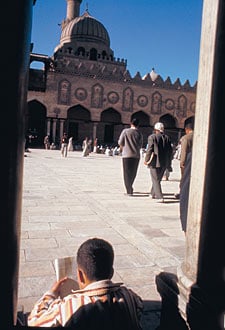 |
| JOHN FEENEY / PADIA |
| Established by the Fatimid caliphate in 971, only two years after the founding of the city of Cairo itself, Al-Azhar University was the centerpiece of learning in a caliphate whose policy was to support the education of ambitious men from humble ackgrounds—such as Ali ibn Ridwan. |
The “new star,” today simply called SN1006, first appeared on the evening of April 30, 1006. It persisted through the summer, but by mid-August the sun had moved so close to it that, from Cairo, it was above the horizon only during the daylight hours, making further observation difficult. According to Chinese accounts, within two years it was no longer visible at all. It appeared low in the southern sky, in the sign of Scorpio, which Ibn Ridwan interpreted as a portent of ill fortune.
Ibn Ridwan later noted, without offering specifics, that “calamity and destruction” in fact followed in that year. Indeed, ill fortune seemed to lie in wait for many in his day. The Fatimids had captured Egypt, establishing Cairo as their capital, only 37 years earlier. Its ruler, Caliph
Al-Hakim, was only three years older than Ibn Ridwan. The caliph had been a boy of 11 when his father died, and at 15 he arranged the assassination of the administrator who had usurped his rightful powers. Though popular with his subjects at first—he mingled with the crowds during both Muslim and Christian holidays—he remained suspicious of court officials and did not hesitate to execute those who displeased him.
For young Ibn Ridwan, however, good fortune also beckoned. The year before the supernova appeared,
Al-Hakim had founded the Dar al-‘Ilm, “the House of Knowledge.” This was a sort of informal public university where anyone who wished might come to read and copy books, study, or attend lectures in theology, grammar, philology, medicine and astronomy. Astrology was excluded, for a distinction had emerged between the empirical discipline of astronomy and what many, including Al-Hakim, regarded
as its less respectable, interpretive counterpart.
In 1013 Al-Hakim would forbid the practice of astrology and later banish a number of astrologers. He patronized astronomers like Ibn Yunus, who produced a set of astronomical tables so accurate they took into account the
atmospheric refraction of the sun’s rays at the horizon, and
a few years after founding the Dar al-‘Ilm, Al-Hakim began construction of an astronomical observatory.
Though Ibn Ridwan makes no mention of the Dar al-‘Ilm in his autobiography, its foundation is indicative of the intellectual atmosphere of Cairo that thrived alongside its volatile politics. As a child, Ibn Ridwan would have received his basic education at a local mosque, including reading and writing and the recitation of the Qur’an. At 15, he embarked on his medical and philosophical studies. “I had no fortune,” he says, “from which I could have paid for my education and so my studies were hampered by obstacles and difficulties. Sometimes I earned my livelihood by practicing astrology, again by medical practice, and yet again by giving lessons.”
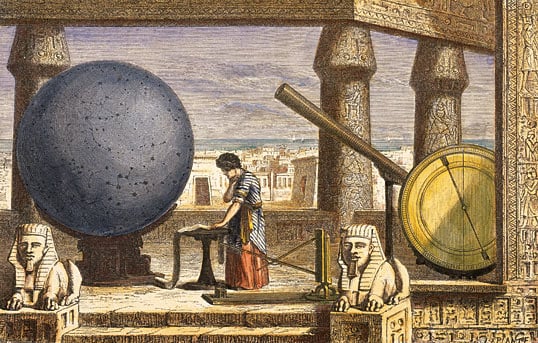 |
| HERMANN GOELL / ARCHIV FÜR KUNST & GESCHICHTE / AKG-IMAGES |
| By Ibn Ridwan’s time, observation of the stars and planets—for empirical, religious and astrological reasons—had a long history in Egypt. This 19th-century woodcut is a fanciful depiction of Claudius Ptolemy’s famous first-century observatory at Alexandria. From there, Ptolemy made the observations that supported Earth-centered models of solar and planetary motion. |
The prevailing system of medical study disappointed him. Students customarily paid a substantial fee to attach themselves to a well-known teacher and memorize the works he assigned. But Ibn Ridwan says his own teacher “explained no obscure point and added no single word to whatever it was that was being read, but simply listened as the student read it.” In disgust, Ibn Ridwan abandoned him. He heard
of a better teacher in Iraq, but could not afford to travel there. Instead, he began to read the classical Greek medical authority Galen on his own. When he read that only those trained in geometry or logic could understand Galen’s teachings, he paused to learn both. Then he returned to his close study of Galen and added Hippocrates.
A physician friend finally took him on as an assistant. Ibn Ridwan gained practical experience as the physician’s substitute and built up
a clientele of his own. “My office,” he says, “was medicine and astronomy.” (He evidently found it prudent, whatever astrological services he may have offered his clients, to advertise himself as an astronomer.) In his personal library, he kept a copy of the Tetrabiblos,
an astrological work by the second-century astronomer and mathematician Ptolemy, which includes a chapter on the roles various planets might play
in causing diseases and injuries.
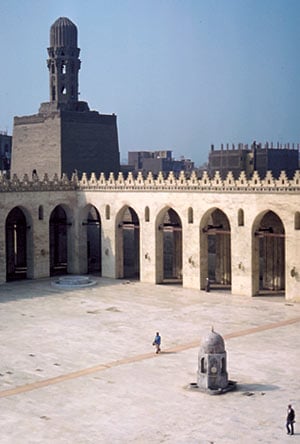 |
| JOHN FEENEY / PADIA |
| The mosque founded by caliph Al-Hakim in 990 was under construction when the 1006 supernova appeared in the sky, and it was completed in 1013—the same year the caliph officially banished astrologers. |
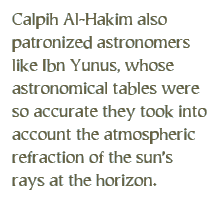
Ibn Ridwan later wrote an extensive commentary on the Tetrabiblos. Like Ptolemy, he believed astrology could be useful for understanding the past and predicting future conditions, but he considered it an imprecise art compared with the mathematical and geometrical calculations
of astronomy. In one of
his medical treatises, Ibn Ridwan expressed scorn for a colleague who insisted on consulting the stars before considering a patient’s illness.
Not until age 30 did Ibn Ridwan feel sufficiently established in his profession and secure enough financially to marry and buy a house. He continued his studies another year until, he wrote, “I achieved a reputation in medicine.” He was appointed, probably around this time, to be chief physician to Caliph Al-Hakim.
However exalted, a life this close to Al-Hakim could hardly have been serene. Indeed, some historians think the caliph was insane. In 1018, not long before Ibn Ridwan’s appointment, a heretical cult had arisen which asserted that Al-Hakim was an incarnation of God. The caliph seemed to encourage the cult, infuriating many of his subjects. Riots broke out. Besides executing court officials, the caliph persecuted Christians and made oppressive laws confining women to their homes. He conducted state business at night, and he often went riding in the desert after dark. On February 13, 1021, he went on one of his nocturnal rides and never returned. Searchers found only his mutilated donkey and his bloodstained clothes. For the next two years, his elder sister Sitt al-Mulk ruled as regent for Al-Hakim’s young son. When she too died, 17-year-old Al-Zahir became caliph for the next 13 years.
Those turbulent times must have troubled Ibn Ridwan. He later wrote that epidemic diseases could break out “when
a common fear of a ruler grips the people. They suffer prolonged sleeplessness and worry about deliverance or the possibility of trouble.” Professionally, though, he prospered. He invested in real estate so
he could look forward to a comfortable retirement. He took on medical students of his own, and his reputation spread as far as Makran, in Baluchistan, whose ruler consulted him after being partly paralyzed. Ironically and tragically, despite his medical renown, Ibn Ridwan could not save the lives of his own son and three daughters, all of whom died in childhood.
His writings show a prickly, even defensive personality—perhaps due partly to his unconventional, bootstrap education, the stress of serving Al-Hakim and his personal misfortunes. Professionally, he feuded. When Ibn Butlan, a Christian physician from Baghdad, visited Cairo from 1049 to 1052, the two argued over the constitutions and relative temperatures of baby chicks and birds so fiercely that Ibn Ridwan accused Ibn Butlan of
ugliness and Ibn Butlan retorted that Ibn Ridwan had “the face of a buffalo and eyes like a cow.”

By the time of his death, probably in 1067 or 1068, Ibn Ridwan had written more than 100 works, mostly commentaries on Galen and Hippocrates or medical treatises, several of which he dedicated to his Jewish friend and colleague Yahuda ibn Sa‘ada. He also wrote on philosophy, theology, natural science, astronomy and astrology.
It is in one section of his commentary on Ptolemy’s Tetrabiblos that we find a passage devoted to the unique heavenly spectacle he had witnessed in his youth—SN1006.
From other accounts, we know today that the supernova had appeared as far north as the monastery of Sankt Gallen in Switzerland; it must thus have been visible around the world at any latitude south of Sankt Gallen. But no other observer described it with the scientific precision of Ibn Ridwan:
The sun on that day was 15 degrees in Taurus and the spectacle in the 15th degree
of Scorpio. This spectacle was a large circular body, two and
a half to three times as large
as Venus. The sky was shining because of its light. The intensity of its light was a little more than a quarter of that of moonlight. It remained where it was and it moved daily with its zodiacal sign until the sun was in sextile with it in Virgo, when it disappeared at once. [From Bernard R. Goldstein’s translation]
He then detailed the positions of the sun, moon and other planets, down to their degrees and minutes in each sector of the zodiac.
 |
| COURTESY FRANK WINKLER |
| Today, the supernova known to astronomers as SN1006 is only a faint, spherical shell of gas that continues to expand at an estimated 2900 kilometers (1800 mi) per second, or about one percent of the speed of light. This photo shows part of the shell passing through trace amounts of interstellar matter. |
A millennium later, we know that what Ibn Ridwan witnessed was a supernova, the cataclysmic explosion that marks the death
of a star.
As a young faculty member in the 1970’s, Middlebury College astrophysicist Frank Winkler had the opportunity to study satellite data on x-ray emissions from space, and he wanted to see if he and his students could use this and other data to locate the remains of SN1006.
A team of English and Australian astrophysicists used Ibn Ridwan’s data in 1977 to narrow down the area of sky in which the supernova could have occurred. While the Swiss
record established the northern limit
of the supernova’s visibility, only Ibn Ridwan, Winkler explains, gave its position “along the ecliptic, that is,
the path that the planets follow through the sky.” Winkler and his
students combed through the x-ray data looking for an emission source
in the right area.
“Lo and behold,” he says, “we were definitely able to detect it.”
It was the beginning of Winkler’s long fascination with SN1006. Winkler’s current work focuses on its distance from Earth, its brightness and the material the exploding star ejected into space. He’s still learning about the composition of the remnant, but in 2003 he was able to obtain a more precise estimate of its distance from Earth than had previously been possible by comparing a series of digital images taken in the 1980’s and 1990’s: His estimate that it is just over 7000 light-years from Earth is widely accepted.
 |
| MAX PLANCK INSTITUTE FOR EXTRATERRESTRIAL PHYSICS |
| Million-degree plasma inside SN1006’s shell still emits radiation at nearly all wavelengths; x-rays, shown here, are among the most abundant. Despite this formidable energy a millennium after its blast, the plasma is so diffuse, and the interstellar void so empty, that the atomic matter of the plasma travels virtually unimpeded. |
How bright was SN1006? Once again, Ibn Ridwan helped provide the answer. His account was the only one to compare the supernova’s brightness with that of both Venus and the moon. “Since we know how bright Venus gets,” Winkler says, “and we know the brightness of the full moon, we can use those as benchmarks along with Ibn Ridwan’s description to peg the intermediate spot in between them that leads us to an estimate for how bright the 1006 supernova would have been, at its peak.”
Astronomers measure brightness—or “magnitude”—along a logarithmic scale in which the brighter stars have lower numbers. Using their knowledge of SN1006 and its distance from Earth, Winkler and his team calculated its maximum brightness at a magnitude of -7.5. This squares neatly with Ibn Ridwan’s estimate and makes it the brightest supernova in recorded history.
“That’s about a hundred times brighter than Jupiter
ever gets,” Winkler says, or “250 times brighter than Sirius,” the brightest star in the sky. Furthermore, it would have twinkled strongly because of the angle at which it appeared through the atmosphere. In Cairo, it never rose higher than about 23 degrees over the horizon—hold your hand at arm’s length with fingers spread and the tip of your thumb on the horizon, and that’s about where the tip of your little finger will be.
“It would have been twinkling like crazy,” Winkler says.
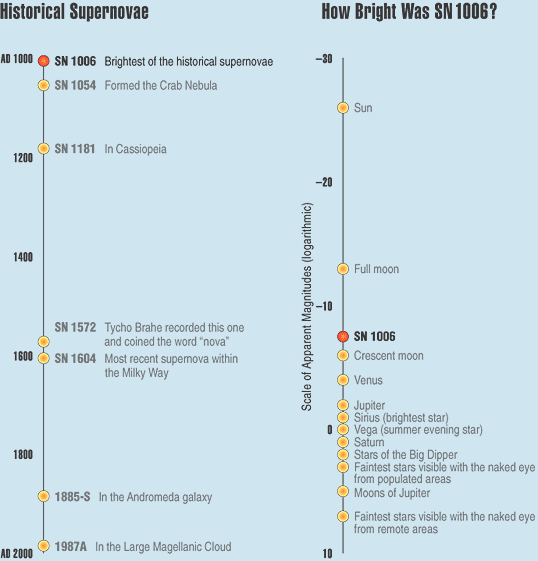
 |
Margaret Donsbach (margad@earthlink.net) is a free-lance writer in Portland, Oregon who specializes in history. Her work has appeared in Military History, Civil War Times and Art Times, among other publications. |